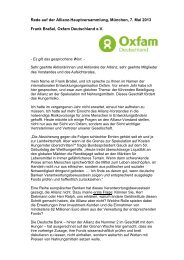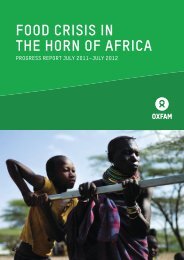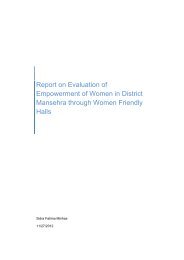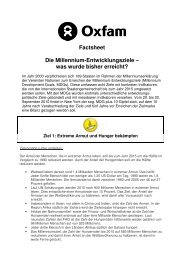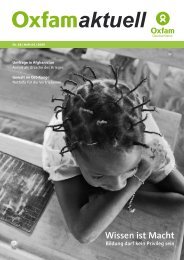shape - Oxfam
shape - Oxfam
shape - Oxfam
Create successful ePaper yourself
Turn your PDF publications into a flip-book with our unique Google optimized e-Paper software.
CONCLUSION<br />
This case study has attempted<br />
to show how one organisation,<br />
SHAPE Zimbabwe Trust, is<br />
responding to HIV among a very<br />
specific group of young people,<br />
namely university students.<br />
The case study has highlighted<br />
the unique strategies that SHAPE<br />
is using to engage university<br />
students in dialogue around HIV<br />
and gender issues and some of<br />
the challenges that it continues<br />
to face in this work.<br />
The key learning points to be<br />
taken from the SHAPE experience<br />
are that HIV programming for<br />
young people must be flexible,<br />
participatory, ongoing<br />
and moulded around a specific<br />
behaviour change model.<br />
As the case study has shown,<br />
there is need to challenge young<br />
people to think differently as well<br />
as provide them with the space<br />
to actually implement activities in<br />
their own unique ways and using<br />
their own strategies. This allows<br />
young people to be involved at<br />
their own pace and to influence<br />
each other in a non-threatening<br />
manner. HIV prevention programs<br />
must also address underlying<br />
gender inequities that fuel<br />
risk-taking behaviour among<br />
men and increase women’s<br />
vulnerability to infection.<br />
SHAPE continues to modify<br />
its Gender, Masculinities and<br />
HIV project in accordance with<br />
emerging issues on the ground.<br />
It is this responsiveness and<br />
flexibility that makes SHAPE a<br />
popular choice for university<br />
students, not only at the MSU<br />
but also in all the other campuses<br />
where it is working.<br />
As SHAPE MSU Program<br />
Manager Leo Wamwanduka<br />
notes, “rigidity does not work<br />
with students at all”.<br />
BELOW: Chinzou, a second year media student<br />
at MSU, acts out how men take advantage of<br />
girls and young women affected by poverty.<br />
Photo: William Nyamuchengwa/<strong>Oxfam</strong>AUS.<br />
ABOVE: A SHAPE banner promoting positive masculinity. Photo: William Nyamuchengwa/<strong>Oxfam</strong>AUS.<br />
AS A MAN I THOUGHT THAT WOMEN<br />
WERE NOTHING BUT CREATURES<br />
THAT WERE CREATED AFTER MEN AND<br />
ARE THERE TO SATISFY OUR EROTIC<br />
DESIRES, BUT I WAS PROVED WRONG.<br />
I REALISED THAT THIS WAS TOXIC<br />
MASCULINITY. SHAPE ZIMBABWE<br />
PROGRAMS EQUIPPED ME WITH<br />
INFORMATION ABOUT HOW WE<br />
SHOULD RELATE TO OUR FELLOW<br />
COUNTERPARTS (WOMEN). WE ARE<br />
EQUAL AND ALWAYS EQUAL.<br />
OWEN, FOURTH-YEAR STUDENT.<br />
Acknowledgements<br />
This case study was produced through<br />
the skills, knowledge, cooperation and<br />
hard work of many dedicated people.<br />
Firstly, thank you to SHAPE Founder and<br />
Executive Director Shepstone Musiyarira,<br />
SHAPE Midlands State University Program<br />
Manager Leo Wamwanduka and the entire<br />
SHAPE team for their time, energy and<br />
cooperation in the development of this<br />
case study.<br />
Thank you also to the all the students at<br />
Midland State University who shared their<br />
stories and expressed their willingness to<br />
be involved in this case study.<br />
Thank you to Tsitsi B Masvaure,<br />
Margaret Roper and Leo Wamwanduka<br />
for their research and writing skills and<br />
to COGENHA staff for their input<br />
and assistance.<br />
The opinions of authors or participants in<br />
this document do not necessarily reflect<br />
those of <strong>Oxfam</strong> Australia, <strong>Oxfam</strong> affiliates,<br />
COGENHA or its staff.<br />
BACK COVER: SHAPE MSU<br />
Program Manager Leo<br />
Wamwanduka and SHAPE peer<br />
educator and gender activist Willard<br />
Barure take part in a role play to<br />
show students how the HIV attacks<br />
the body’s immune system. Photo:<br />
William Nyamuchengwa/<strong>Oxfam</strong>AUS.<br />
References<br />
1<br />
United Nations Development<br />
Programme (UNDP) 2006, Human<br />
Development Report 2006,<br />
Palgrave Macmillan, Hampshire<br />
2<br />
Ibid.<br />
3<br />
Central Statistical Office Harare,<br />
Zimbabwe 2006, Zimbabwe<br />
Demographic and Health<br />
Survey2005–2006, Harare.<br />
4<br />
Joint United Nations Programme<br />
on HIV/AIDS (UNAIDS) 2006,<br />
Zimbabwe Country Situation<br />
Analysis www.unaids.org/en/<br />
Regions_Countries/Countries/<br />
zimbabwe.asp<br />
Published July 2007<br />
<strong>Oxfam</strong> Australia<br />
132 Leicester Street<br />
Carlton 3053<br />
Victoria Australia<br />
ABN 18 055 208 636<br />
Telephone: +61 3 9289 9444<br />
Facsimile: +61 3 9347 1983<br />
Website: www.oxfam.org.au<br />
Email: enquire@oxfam.org.au<br />
Author: Tsitsi B Masvaure<br />
Editor: Maureen Bathgate<br />
Picture editor: Martin Wurt<br />
Proofreader: Chris Robinson<br />
Print coordinator: Kim Hayes<br />
Design: Paoli Smith<br />
Print: Work & Turner<br />
Contributors:<br />
Margaret Roper<br />
Maureen Bathgate<br />
Leo Wamwanduka<br />
Bridgette Thorold<br />
Doreen Mukwena<br />
Benny Mushowo<br />
Photographs:<br />
William Nyamuchengwa<br />
Jane Willey<br />
Bridgette Thorold<br />
Printed on Cyclus Matt, an<br />
unbleached coated paper<br />
made from 100% recycled<br />
post consumer waste, using<br />
vegetable-based inks.<br />
30 31



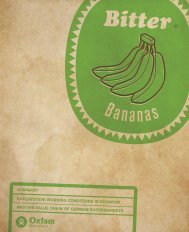
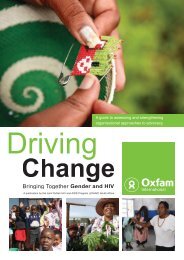
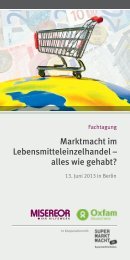
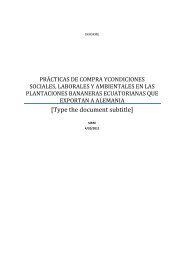

![Download: Faltposter EU-Handelspolitik [PDF 2,17MB] - Germanwatch](https://img.yumpu.com/25095854/1/190x161/download-faltposter-eu-handelspolitik-pdf-217mb-germanwatch.jpg?quality=85)
